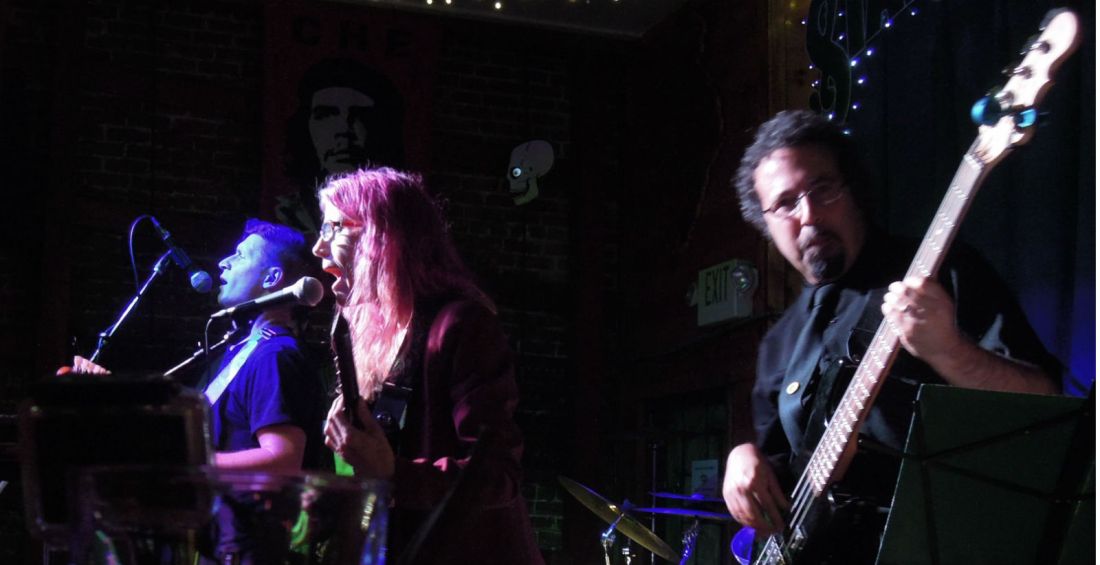 I had been vaguely aware that Ahmed Abdul-Malik, Thelonious Monk’s onetime bassist, had made strides in mixing “world music” with jazz back in the ’60s, but never investigated the specifics. Coming across his 1965 album Spellbound in a store one day, I decided to give it a try.
I had been vaguely aware that Ahmed Abdul-Malik, Thelonious Monk’s onetime bassist, had made strides in mixing “world music” with jazz back in the ’60s, but never investigated the specifics. Coming across his 1965 album Spellbound in a store one day, I decided to give it a try.
Turns out it’s the wrong place to start, but it got me on the right path eventually.
From hanging out at a college radio station, I certainly had heard of the oud, a lute-like instrument that’s ubiquitous in Mediterranean music of the Arabs, Turks, and Greeks. Jazz-minded oud is not hard to find. Oud player Anouar Brahem has gotten a lot of good exposure from ECM Records. There’s also Ravish Momin’s Trio Tarana, an oud-violin-drums band applying jazz soloing ideas to its calmly acoustic Middle Eastern grooves. (More recently, Momin has ventured into electronica with a duo simply called Tarana.)
Spellbound‘s attempt at world jazz, though, is heavy on the jazz. It’s primarily an evening-bop album, well executed straightahead stuff. Oud player Hamza Aldeen appears on only two of the LP’s four original tracks (a bonus track on the CD is an oud-less blues), and his lone solo, on “Song for Delilah,” is treated like an externality — the lone oud with very light bass and a whispered hi-hat beat.
Turns out, Spellbound was Abdul-Malik’s final album as a leader. His previous albums were more involved efforts at introducing the oud and Middle Eastern musical styles to a jazz audience.
 Jazz Sahara, from 1958, is the one that’s called out by Jazz Times in this 2012 article. This is a full-out Middle Eastern band complete with Abdul-Malik on oud; Jack Ghanaim on the kanun (qanun), a jangly stringed instrument; and Mike Hamway on the goblet drum (darabeka) — plus saxophone solos by Johnny Griffin. Track times are around 10 minutes each, providing plenty of space for a chantlike groove to simmer.
Jazz Sahara, from 1958, is the one that’s called out by Jazz Times in this 2012 article. This is a full-out Middle Eastern band complete with Abdul-Malik on oud; Jack Ghanaim on the kanun (qanun), a jangly stringed instrument; and Mike Hamway on the goblet drum (darabeka) — plus saxophone solos by Johnny Griffin. Track times are around 10 minutes each, providing plenty of space for a chantlike groove to simmer.
Griffin, of course, adds the key “jazz” element to the setting. He has a grand time soloing over the changes but hits the novelty angle a bit too hard by quoting, at various times, “Salt Peanuts,” “Surrey With the Fringe on Top,” or the opening shadows of “‘Round Midnight.”
Quotes aside, Griffin’s solos work well, but I get more out of Lee Morgan’s trumpet solos on East Meets West, Abdul-Malik’s 1960 date. Morgan seems more willing to let the surrounding single-chord rhythm steep and flow around him. The carefully emerging trumpet solo on “El-Lail (The Night)” is particularly delicious.
With its longer track times, Jazz Sahara leaves more space for that Middle Eastern sound to brew, and in that sense it feels more authentic. But I find I like many of the shorter, tune-length tracks on East Meets West, partly for the contributions of Morgan. It seems clear, though, that Jazz Sahara was Abdul-Malik’s shot at a real “world music” kind of album. East Meets West feels like it has some business compromises, not only the mainstream-friendly track times but also the inclusion of one straightahead jazz number, “Searchin.'”
Maybe Spellbound represented further compromise. Then again, Abdul-Malik never stopped playing normal jazz; you could also view the album — two of its tracks, anyway — as a true melding of the oud into a full-on jazz setting, rather than a more comfortable environment.
Spellbound is a more-than-competent album, with some eye-opening violin solos by Ray Nance (better known as a cornetist for Duke Ellington), but I’ll stick to the more world-music sounds of Abdul-Malik’s earlier albums.
 Oakland-based trio Sound Etiquette starts with the ingredients of fusion and soul — electric piano, sax, and drums, and an open spirit. What they create, though, are improvised pieces across an impressive spectrum of moods ranging from jazzy to jamming to abstract.
Oakland-based trio Sound Etiquette starts with the ingredients of fusion and soul — electric piano, sax, and drums, and an open spirit. What they create, though, are improvised pieces across an impressive spectrum of moods ranging from jazzy to jamming to abstract.


 I’ve never been able to fully commit to saxophonist
I’ve never been able to fully commit to saxophonist 


